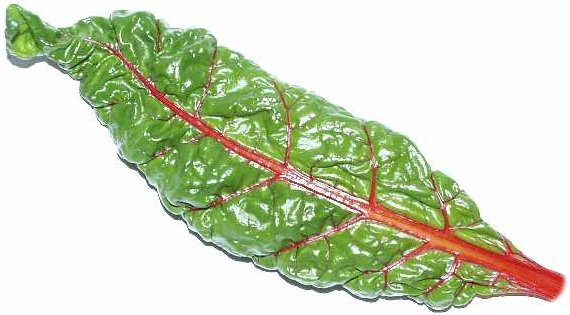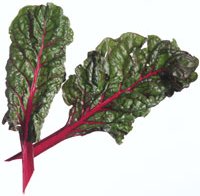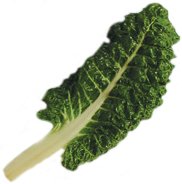

Swiss Chard

(silver chard, seakale beet, silver beet, spinach beet, perpetual spinach). Beta vulgaris subspecies cicla. Chenopodiaceae. A biennial related to the beetroot but cultivated for its edible leaves. The subspecies contain a range of forms from those primarily grown for their dark green, spinach-like leaves to the chards in which the midribs are more pronounced and fleshy and the petioles swollen. In chards, the leaf blade is usually removed and the remaining central portion used as a separate vegetable. Leaf stalks vary in colour and are available in white, pink, red and silver-coloured forms; they are sometimes used ornamentally. Leafy beets were probably developed from an ancestral form native to the Mediterranean region. Swiss chard is now widely cultivated in temperate regions, and although a cool-season crop it is successfully cultivated in highland tropical regions including parts of Northern India and South America. Harvesting can continue throughout the year in many areas but crop quality may be improved by covering the cloches during the winter months. The crop is cooked by boiling. The midribs and leaf bases are treated as for seakale, the more leafy portions in a similar manner to spinach. The crop will tolerate a slightly shaded site but grows best on a deep fertile soil rich in organic matter, well drained and moisture retentive. The pH should be neutral to slightly alkaline and acid soils should be limed. Adequate nitrogen is essential for rapid leaf growth and topdressings of nitrogenous fertiliser may be beneficial during growth. The first sowings should be made as soon as soil conditions permit and continued through the spring at three-weekly intervals to provide a supply of leaves throughout the summer. Seeds should be sown in drills 2cm deep, 30cm apart, with final within-row spacings of about 30cm following thinning. Winter crops are sown during the summer months, increasing within-row spacing to 22cm between plants. Under favourable conditions these will provide a supply of leaves through the winter months in the following spring. 
Plants must be kept well supplied with water throughout growth, and hot dry conditions in summer may cause premature bolting. Recommended cultivars of the leafy forms include ‘Perpetual Spinach’. For chards, ‘Fordhook Giant’, ‘Large White Broad Ribbed’ and ‘Lucullus’ with thick white midribs, ‘Rhubarb Chard’ with bright red midribs and ‘Rainbow Chard’ with stems shaded red, yellow and white, are recommended. Liable to the same diseases as other types of beet and of these, ramularia leaf spot, cercospora leaf spot or blight, and downy mildew are the most likely fungal diseases to be encountered in gardens. Although chard is valuable as an early crop of spinach after overwintering, this has to be balanced against the potential it provides for carry over of virus diseases. A break in cropping, so that seedlings are not infected by the insect transmission of virus from last season’s crop, is recommended. Control of weeds which may form alternate hosts is also important.
|
Home
Grow Nuts
Grow Herbs
Grow Fruit
Cyberian Index
If you like this website and want one of your own contact
Cyberian All information correct at
time of publication and open to updates as necessary. No part of this website,
or its vectors, may be produced in any shape or form, using any type or design
of medium, system, equipment or otherwise without the prior written consensual
notice of the Cyberian. Any breach of these requirements will result in the
appropriate action. If in doubt, e-mail contact is recommended.
Some components of this website were obtained as open-source software and are
used in the same non-profit manner on this website.